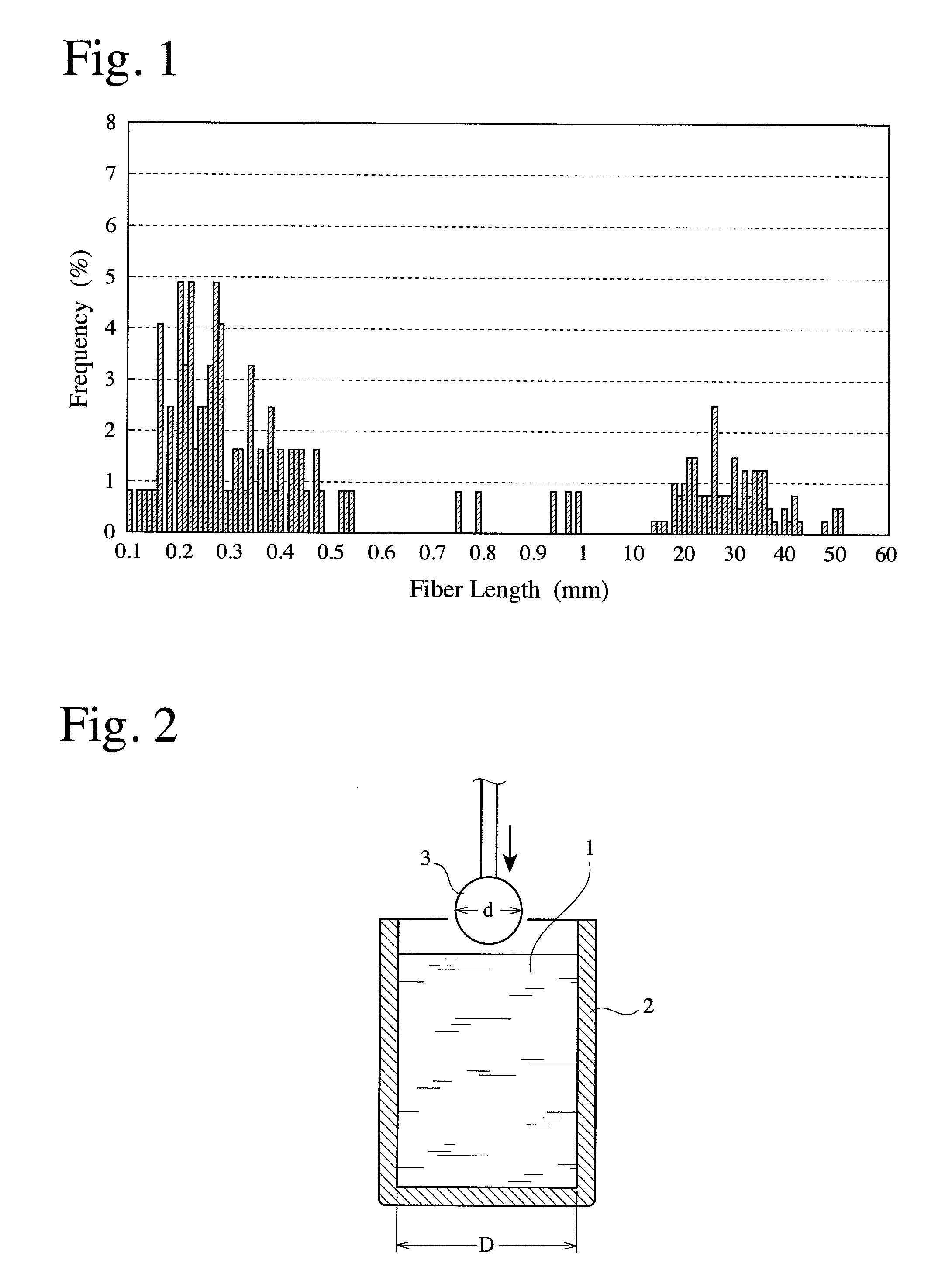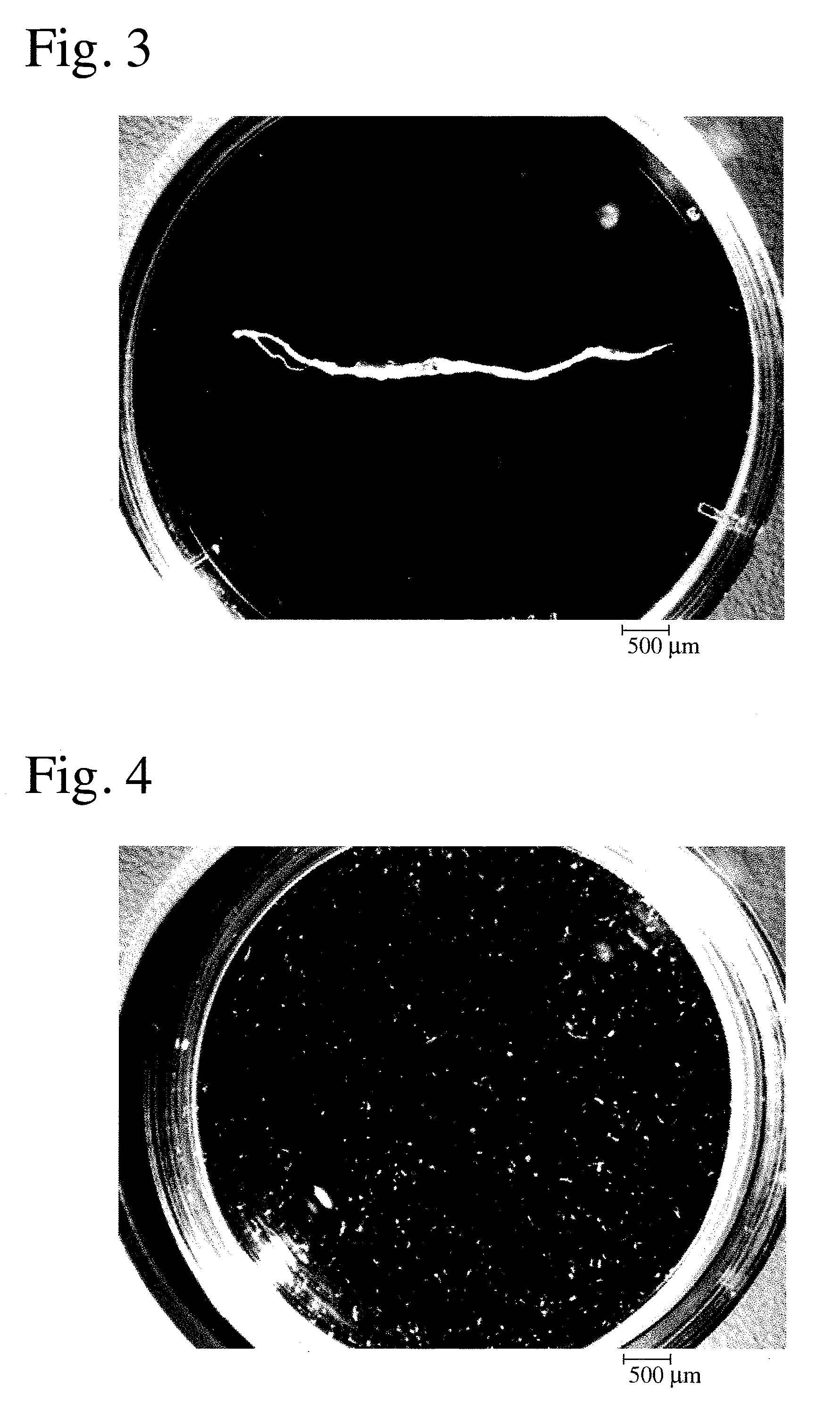Method for producing porous body comprising apatite/collagen composite fibers
a technology of collagen and composite fibers, which is applied in the field of producing a porous body comprising an apatite/collagen composite fiber, can solve the problems of bone fracture, hardness and brittleness of so-called artificial ceramic bone made only of apatite, and inability to completely match human bone mechanical properties and physiological properties with human bone, etc., and achieves high bone-forming capability.
- Summary
- Abstract
- Description
- Claims
- Application Information
AI Technical Summary
Benefits of technology
Problems solved by technology
Method used
Image
Examples
example 1
[0053](1) Production of Long Apatite / Collagen Composite Fibers
[0054]412 g of an aqueous solution of collagen in phosphoric acid (concentration: 0.97% by weight, phosphoric acid: 20 mM) was added to 400 g of a 30-mM aqueous phosphoric acid solution and stirred to prepare a solution a-1. 400 ml of a 100-mM calcium hydroxide solution (solution b-1) was also prepared. After 200 ml of water was charged into a reactor, the solutions a-1 and b-1 were simultaneously dropped, and the resultant reaction solution was stirred. With the pH of the reaction solution kept at 8.9-9.1 during dropping, formed slurry was frozen and freeze-dried.
[0055]The resultant fibers had an average length of 65 mm. The optical photomicrograph of a long apatite / collagen composite fiber is shown in FIG. 3. An apatite / collagen ratio in the long apatite / collagen composite fibers was 8 / 2 by mass.
[0056](2) Production of Short Apatite / Collagen Composite Fibers
[0057]412 g of an aqueous solution of collagen in phosphoric ac...
examples 2 and 3
[0064]Each gel molding was produced in the same manner as in the steps (1) to (4) in Example 1 except for changing the mixing ratio of the long apatite / collagen composite fibers to the short apatite / collagen composite fibers to those shown in the columns of Examples 2 and 3 in Table 1, and compressed from above by a ball to measure the gel strength. Their length distributions of the apatite / collagen composite fibers are shown in FIGS. 7 and 8, and their measured gel strengths are shown in FIG. 5 and Table 2.
[0065]Each gel molding was frozen and dried, and then cross-linked during thermal dehydration in the same manner as in the step (5) in Example 1, to obtain an apatite / collagen porous body. The scanning electron photomicrographs (SEM photographs) of the cross sections of the porous bodies are shown in FIGS. 9 and 10.
reference example 1
[0068]A gel molding was produced in the same manner as in Examples 1-3, except that 1 g of short apatite / collagen composite fibers, and 1 g of an aqueous phosphoric acid solution containing collagen as a binder (concentration: 0.97% by weight, and phosphoric acid: 20 mM) were stirred with 7.87 ml of PBS. After the strength of the gel molding was measured, collagen in the molding was cross-linked. The measured gel strength is shown in FIG. 5 and Table 2. The SEM photograph of the cross-linked body is shown in FIG. 13.
[0069]
TABLE 1Mass RatioNo.Long FibersShort FibersExample 10.250.75Example 20.50.5Example 30.750.25Comparative01Example 1Comparative10Example 2Reference01Example 1
[0070]
TABLE 2No.Load (N)Example 10.14Example 20.12Example 30.14Comparative0.06Example 1Comparative1.35Example 2Reference0.08Example 1
[0071]The porous bodies of Examples 1-3, Comparative Examples 1 and 2, and Reference Example 1 were measured with respect to porosity and a force necessary for 3-mm compression. Th...
PUM
| Property | Measurement | Unit |
|---|---|---|
| length | aaaaa | aaaaa |
| length | aaaaa | aaaaa |
| length | aaaaa | aaaaa |
Abstract
Description
Claims
Application Information
 Login to View More
Login to View More - R&D
- Intellectual Property
- Life Sciences
- Materials
- Tech Scout
- Unparalleled Data Quality
- Higher Quality Content
- 60% Fewer Hallucinations
Browse by: Latest US Patents, China's latest patents, Technical Efficacy Thesaurus, Application Domain, Technology Topic, Popular Technical Reports.
© 2025 PatSnap. All rights reserved.Legal|Privacy policy|Modern Slavery Act Transparency Statement|Sitemap|About US| Contact US: help@patsnap.com



